An ambitious regenerative agriculture project in Guanajuato is putting agave at the heart of a carbon negative future
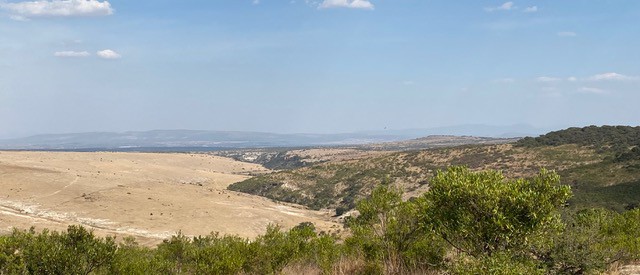
When Sophia Trapp took over her family’s ranch outside of San Miguel de Allende in Guanajuato, Mexico, she was already well established in the environmental field. She’d studied sustainable development and ecosystem restoration and had been putting those disciplines to use in far flung projects like the one that had her planting a multi-level forest to try and reclaim desert land in China and Mongolia.
She’d helped out plenty on the ranch in Mexico. She describes it as a “family project” where she would help out on visits and with advice from afar. But when her mother, Regina, died in 2014 and Sophia took over, little did she know that she would soon be tripping down a rabbit hole of regenerative agriculture that would ultimately result in a mezcal.
How to overcome a legacy of devastation?
The ranch, called Cañada de la Virgen, had once been a landscape flush with trees, agaves, and wildlife. But drought and severe overgrazing had transformed it into a desert. It was a poster child for the human and climate generated problems ravaging much of arid Mexico and the US Southwest. As Trapp says, “20 years ago you didn’t have the sun cooking the soil like you do now.” The area is being hit with a 1,000 year drought as precipitation patterns change, leaving local farmers and ranchers without a way to make a living, or even eat.
This drought runs from Canada right through Mexico. It is forcing everyone who lives in, and depends on, these areas to reconsider how they live. For cities that means rationing water and building plants to desalinate or recycle it. For agricultural areas it means figuring out alternative conservation strategies. Large companies can cope better because they can deploy resources to help cushion the blow. Small farmers and ranchers don’t have those tools. They suffer the most.
That’s where Trapp enters the picture. She says that she was working with “NGOs around the world, we were always talking. So I thought, how is it that we can bring life back?’” Her mother had purchased 5,000 hectares, a little more than 12,300 acres, with the idea that she would raise cattle and help the land recover. The vast ranch also contained a pyramid dating back to the 6th Century CE. A second generation cattle rancher from Argentina, Regina Trapp quickly donated the Cañada de la Virgen pyramid to the Mexican government so that it would belong to the Mexican people, began certifying the ranch as organic, and entered into a federal program to make it into a working nature preserve.
When Sophia Trapp took stock of the land, she was focused on the problem of how to reverse the desertification. She says that she was open to any, and all ideas, that would reclaim the desert and was even “thinking that I might have to get rid of the cows, but then I read about rotational grazing and thought, ‘I can use the cows to benefit the ecosystem regeneration instead of desertification. So we flipped the script.” She started by making the cattle an integral part of her work because she figured that they were already spreading manure everywhere. If she fed them more of the minerals that they needed, they’d distribute mineral rich manure onto the land, which would have the effect of spreading all those minerals across the landscape.
It would be easy enough to say that one thing led to another, but Trapp has painstakingly assembled a variety of technologies and methodologies based on the principles of regenerative agriculture into a larger project. Using cattle manure to distribute minerals led to a focus on agave which led to a focus on cattle feed which led to carbon sequestration and finally, the idea of making an agave spirit. These developments happened through brainstorms and happy accidents. When talking to her it’s easy to get the sense that she just ran into so-and-so who suggested an idea which she pushed into action and “Voila!” another victory for sustainability. The other side of this, the context for the project she’s come to call the Agavesse System (for “the essence of the agave”), is her background. She is a hybrid scientist, big thinker, social networker, rancher, and dynamo. She is focusing that expertise and attention on a very local problem with global implications.
Trapp sums up her project as a large test case to demonstrate “that carbon sequestration works and is a viable revenue stream.” She emphasizes that it has to make economic as well as environmental sense. The big difference, her “paradigm shift is that I’m trying to get at it from the environmental side” and find a template that works at scale. Another guiding factor for her is that “whatever I end up doing, my neighbors have to be able to do it as well.” That means that it also has to be inexpensive and easy to deploy. There’s an old maxim that says “Cheap, fast, easy: Pick one.” Trapp wants all three, and to make them work on thousands of acres.
Manure is just the fertilizer
As Trapp looked around for solutions to her cluster of problems she started with that simple step of feeding her cattle something different. As she tells it “it was that simple, I began feeding my cows the minerals that my soil was missing so that every time they drop a cow patty, they’re adding those minerals to the soil.” That was the beginning of the transformational cycle for, as every grade schooler knows, we’re all part of a larger ecosystem. Contrary to the impulse to just plant a tree, she insists that the soil comes first, that the tree is the end product of that process. So, she started with raw minerals and cow manure and saw some great results.
But she was still missing the key species to tie it all together. Cañada de la Virgen is an arid plain named for the nearby valley cut by the Virgen River. That plain had been over-grazed for years, possibly generations. Native plants that fix water in the soil along with carbon and a variety of valuable items like nitrogen and minerals were sparse. Overgrazing created a vicious cycle of fewer plants, less water retention, and fewer vital minerals which fed on itself and was amplified by the larger process of climate change largely created by the U.S. and Europe.
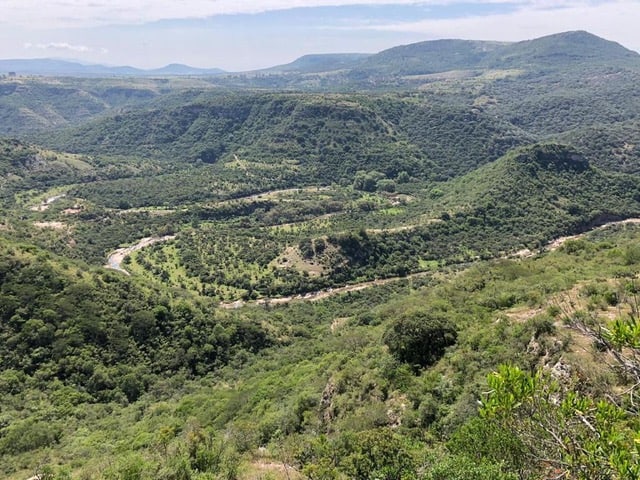
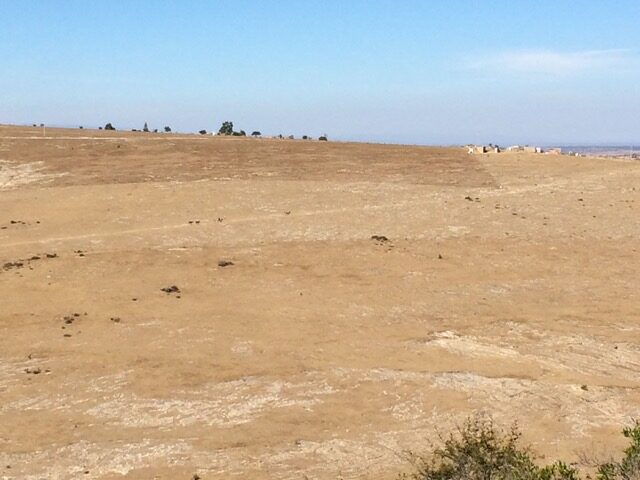
She was a fan of Brad Lancaster who pioneered a method to retain water in arid environments by building berms in Arizona. You can watch his TEDx Tucson Talk but the gist is that you build a berm, plant something on top of it to hold it together, water collects in the depression behind it, which allows other, more water hungry plants, like trees to flourish. She was focused on using the Lancaster berm design but was stumped by what to plant on top of the berm. What plant doesn’t require a lot of water and is well adapted to a desert environment? Perhaps something that might already be growing in the area?
Getting to agave
“There was a moment that I was walking in the ranch. There is the agave and the nopal. There was a drought four years ago. We had a third of the normal rain, then it dried up. The nopal started to eat itself but the agave was still going strong. That was when it was obvious that the agave was the toughest plant in the whole damn place.”
In 2019, Trapp put it all together by planting agave on top of Lancaster’s berms: ““I took Brad’s work and thought ‘oh I can plant agave on top of the berm and trees in the trench. That was always missing for me when I was working previously. I was planting trees but not the ecosystem.”
The last component in this system’s design was its layout. In order to maximize water retention, the berms and the agaves planted on them had to follow the terrain’s contours. Planting in a grid pattern wouldn’t retain water but planting on the model of terraced vineyards is exactly the model that works. Perhaps all those ancient peoples who set up vineyards on vertiginous hills were onto something.
Once she had agaves in the ground she found their survival rates were an incredible 99%, whereas 85% of trees usually die. That created the base environment for everything else to live. After “3-5 years of agaves growing, that creates safe spaces for fauna, spiders, birds nests, and serpents. Then spaces between the berms are wetter and more alive, so that when I start planting the trees, the conditions are completely there for them to survive.“
Later in 2019 Trapp was attending a local biodynamic conference along with other local sustainability pioneers, when last minute invitees Jose Flores and his wife gave a presentation. The Flores family is based in nearby Zamarripa. She says that when the Flores’ stood up to speak “there were three of us paying attention,” but these were the three people ready to hear what they had to say.
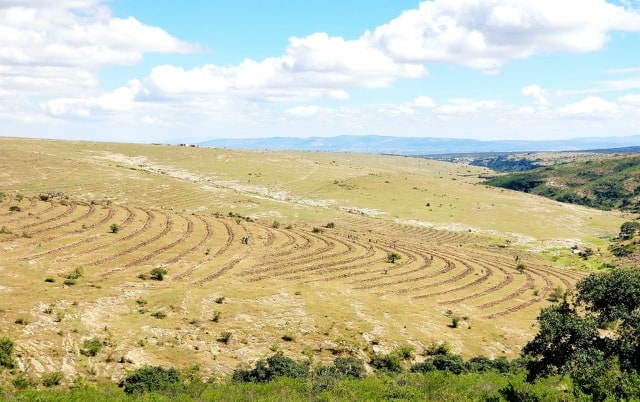
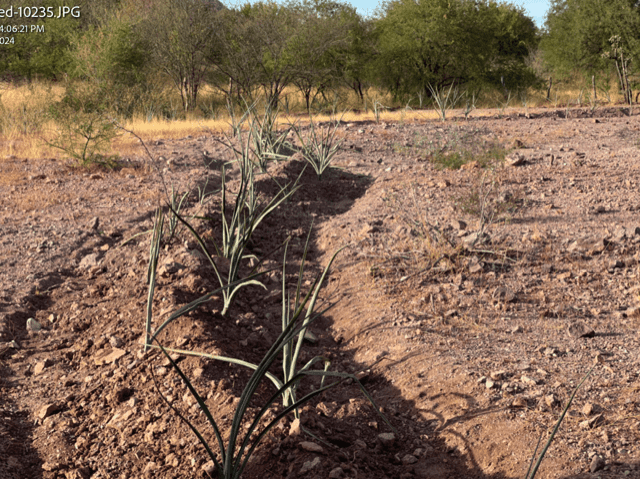
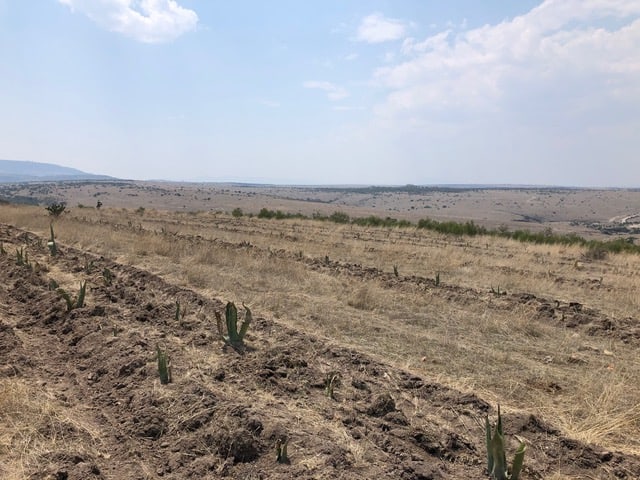
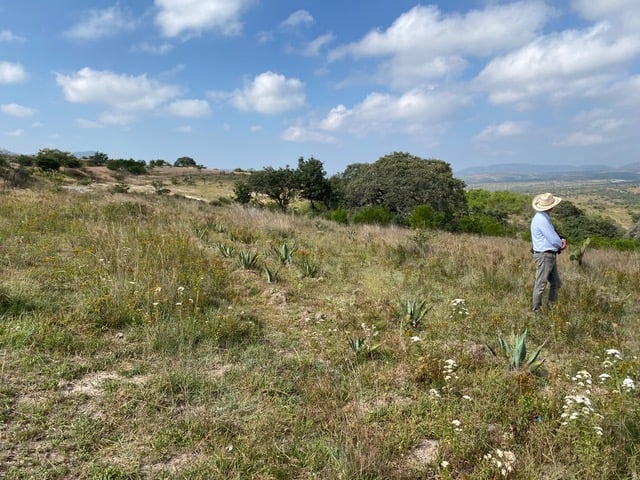
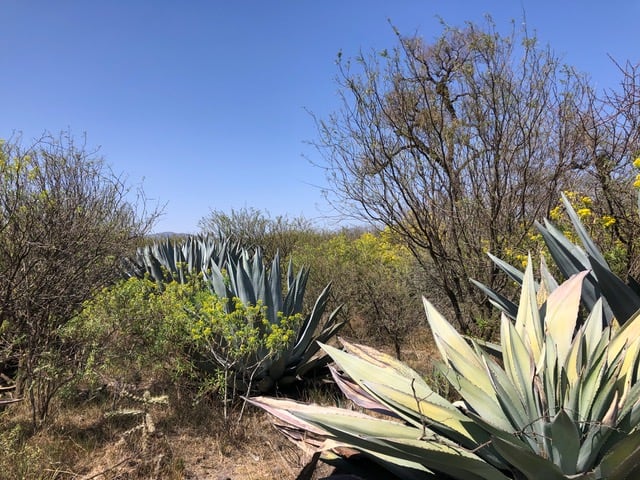
How to make a desert bloom
The Flores González brothers are engineers who had been looking at all the local agave as a potential problem and opportunity. Like Trapp they had inherited a ranch from their father. And, like her, they found their land in a dire state. The land had been in the family for more than 100 years but, Jose Flores told me, what had once been a vital ranch was now “a very degraded land, like the deserts of Sonora and Chihuahua.”
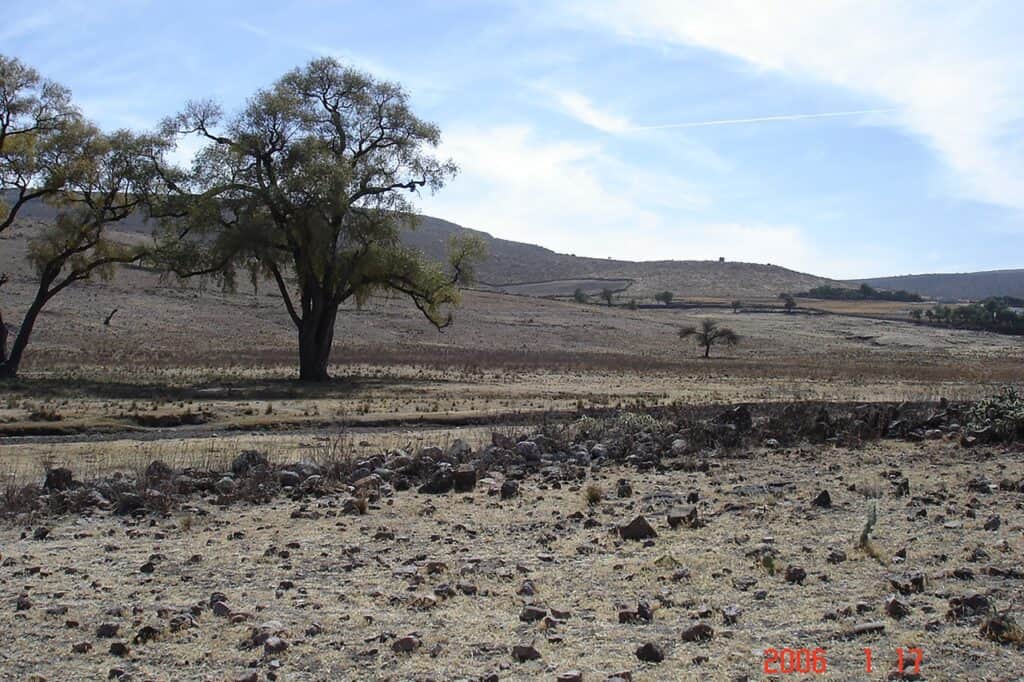
The brothers analyzed the situation and calculated that they were losing 35 tons of soil a year. They knew that they needed a keystone plant to hold that soil in place so they did their research and landed on the agave. But they had another problem: What to feed their animals, especially during the lean winter months. They were looking for which plant had the most fermentable sugars to feed their stock. Their analysis showed that agave was far and away the most sugar rich plant. They tested out an anaerobic fermentation by putting chopped up agave and the leaves – called pencas in Mexico – in plastic bags and found that it worked. But, like many who have started working with agave, they learned that their biggest issue was how to transform that agave into a readily fermentable mass. “Over the year we tested and met results, fermentation depended on the exact size and conditioning of the particulate matter, you need to expose all the fibers to the bacterias that actually make the fermentation go. The smaller the pieces, the more homogenous the fermentation.” Flores says that “at the beginning, we had many people chopping up agave manually, but the output was really low, 300 kilos in 8 hours, so we said, we need to find a machine! We bought a lot of machines, but we couldn’t find any that were specialized to grind up maguey.”
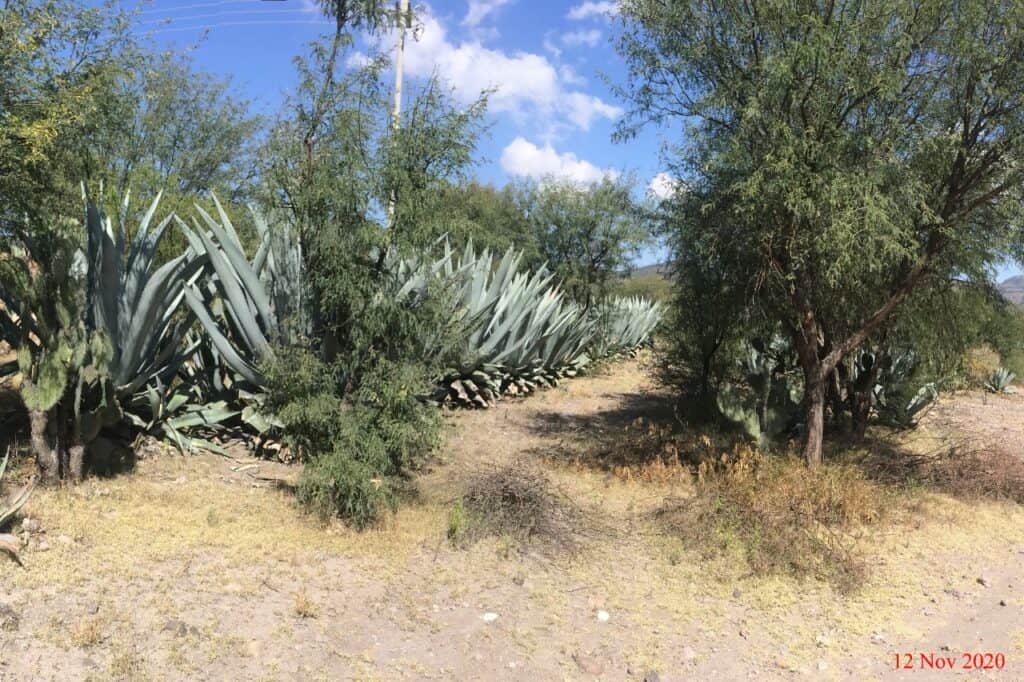
Flores is incredibly engaging. As he walked me through this story he took me down tributary stories about the science behind everything he and his brothers were doing. He notes that they’re used to working in factories where they grind through analytical problems to optimize efficiency. He was bringing that mentality to agriculture and environmental science, a perspective that is both altruistic, he says that he truly wants to leave the world in a better place, and equal parts practical science and economics because he also says that he’d like to do things efficiently and make some money while doing it. So, when he walks you through all these problems and arrives at the issue of a machine that will grind up agave and says “But I have 50 years transforming metal,” then you know it’s both punchline and the start of a good story.
If you’ve ever been in a mezcal distillery, you already know that they are living testaments to the engineering prowess of their owners. There are all sorts of very simple applications of Archimedes’ principle that range from building a distillery on a hill to let gravity manage the transfer of all those heavy agaves, to chopping wood into the same size so that they can get consistent fuel output for their stills. The tahona, the large stone wheel used to mash agave in many distilleries, is an adaptation of a technology used by the Egyptians to crush grain and Chileans to crush rock. Recently distillers have adapted wood chippers and similar technologies to speed that work.
The Flores González brothers leaned on their experience as engineers running factories to test out all the machines they could find but, “we didn’t encounter the machine that satisfied our needs in the market. So we made it over eight months of tests.” That is the Zamarripa Shredder, a machine which they use to create their own fermentable agave mash, and sell to any interested parties.
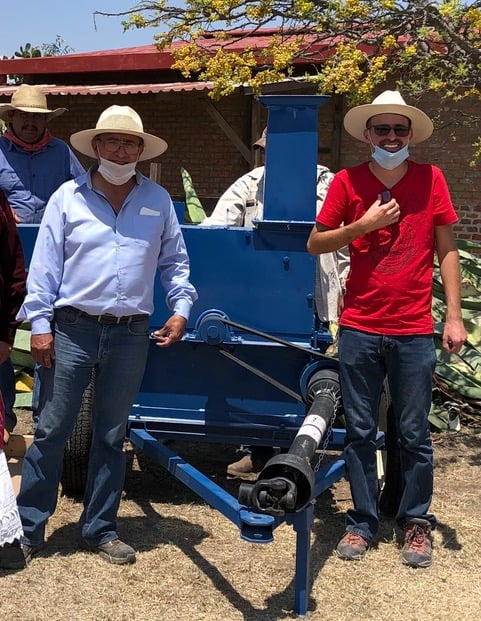

They are growing a hybrid of Agave Americana, Salmiana, and Espadín that grow to 180 kilograms in six years, 250 kilos in eight years, all without irrigation while also fixing carbon into the soil and providing feed for their goats and sheep. The animals help Flores as they “incrementally add to the soil so that I get much more soil, water retention, to produce soil with organic material.” He has tweaked the model further by adding in mashed mesquite seeds which offer his animals even more nutrition and minerals which they spread around the ranch.
When Trapp heard the Flores Brother describing this success, she saw that she could adapt their discoveries to her project and complete the cycle. She could plant agaves on berms across her property. They would hold water in the soil and be the catalysts for a greater transformation that would allow all sorts of foundational species like insects, microbiological elements, and grasses. Water would accumulate in the depressions behind the berms allowing larger plants to grow. And then, she could harvest agave pencas, ferment and feed them to her cattle who would then spread their mineral rich manure everywhere on the ranch and push this process even further forward.
Agave has always been king in Guanajuato
While it is famous as an expat retirement zone, San Miguel de Allende is just a small town in a state defined by arid hills, mines, ranches, and a long history of human habitation. The Otomi people have lived in the area for centuries where they cultivated agave for sustenance and tools. They used agave for three forms of food; aguamiel sap which drips raw from agave, pulque fermented from that aguamiel, and the roasted hearts of agave. The centrality of agave to the Otomi, and most indigenous peoples of Mexico and the US Southwest, didn’t end there: Fibers from beaten and dried agave leaves were woven into clothing, pouches, and blankets while thorns from the tips of the agave were used as needles and a variety of other tasks. Research has been demonstrating that agaves were farmed on a vast and aggressive scale with indigenous peoples domesticating varieties which are still used today.
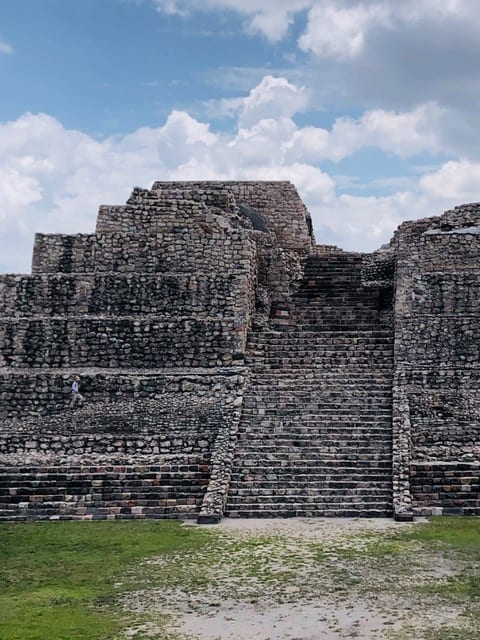
The Otomi were also responsible for the pyramid on Trapp’s land. When she first visited it was completely overgrown. After her family donated it to the Mexican government, it was cleared and has become a very popular tourist site. Research indicates that it was constructed primarily as an astronomical observatory in the 6th Century CE with astronomer priests at the site to observe the movement of celestial bodies. The archeological site features a depressed patio which, archeologists think, was filled with water so that those astronomer priests could observe the stars by looking at the reflection in the water.
Later in the era of Spanish domination and Mexican independence Guanajuato became the center of a vast mining operation. Miners require sustenance and escape from drudgery and, given the long history of agave culture, the explosion of pulque locally seemed almost inevitable. In the late 19th and early 20th Centuries beer took precedence. Salmiana agaves still grow throughout the area and artisanal pulque producers are newly popular. Recently grape vines for local wine are making inroads even if ranching is still a huge local business and cattle graze the lands around the pyramid.
Building an ecosystem on agave
Trapp purchased the Flores Brothers’ shredder but then tweaked their system so that she didn’t have to use disposable plastic bags. She uses 200 liter plastic barrels left over from the sugar industry and ferments for 35-40 days because she found that cattle prefer feed made over a longer ferment period.
While the agave pencas are made into fermented feed, they also reproduce through their own hijuelos – genetically identical plants that pop up around the base of many agaves – which are then continuously transplanted. That means that even more carbon is pulled out of the air and more biomass is created for fermented feed and any other byproducts, like mezcal.
The genius of this system is that it’s incredibly cheap, much less expensive than buying alfalfa and other feed. And, it’s something small farmers can just pick up and do. It doesn’t require any specialized equipment other than the shredder, something that may already be available in mezcal producing facilities. Farmers can trim off leaves as plants mature and use them for fermented feed so that the agave is feeding the entire process through its long lifespan. Trapp and others hope to spawn a cottage industry of itinerant fermenters doing this work.
Trapp had always wanted to make the Agavesse System a model for others but she had to empirically measure its progress and see whether it was really having the intended impact. She could see the feed, the plant growth across the landscape, and feel the forward momentum: But she needed empirical evidence so she brought in Hudson Carbon, a New York based carbon measurement firm led by Ben Dobson, a farmer.


Measuring progress
Talking to Dobson is like reaping the whirlwind. I learned more about global warming in our conversations than the years that the topic has been front page news. His company, Hudson Carbon which is named for the Hudson Valley where he continues to farm the family property today, is focused on measuring carbon sequestration. The concept of how much carbon a plant and its surrounding ecosystem can pull into its body is critical to how the world will deal with climate change because agriculture is one of the largest sources of greenhouse gas emissions. And, it’s critical to how projects like Cañada de la Virgen measure and ultimately judge their success.
For Dobson the key concept is that “Carbon sequestration is code for photosynthesis. Photosynthetic species breathe in carbon dioxide and convert to carbon and oxygen.” So, if you can grow enough plants large enough, then they will pull carbon from the air, sequester it in their own bodies and the earth around them, helping to heal climate damage. They don’t take the cultivated garden approach, they want to work at scale to obtain transformative effects on the climate. While they start by analyzing individual plants, they build models based on that research and use tools like drones and satellites to measure the results.
Key to Hudson Carbon’s analysis of Cañada de la Virgen is developing an allometric equation of agave. Allometrics is the study of plant size and how it relates to other dimensions like carbon sequestration. Dobson’s team is working to create an allometric equation of agave so that they can deploy drones that will measure agave size from the air, feed that data into an algorithm that understands that relationship, and report how much carbon they are pulling out of the air.
Dobson says that they’re seeing that “agave is a great kick starter to succession of growth for desert scrublands.” But it’s also doing a great job in storing carbon. How much? Dobson reports that “we’re seeing that one hectare of agave over a 10 year growth cycle could sequester 95 tons of carbon.” He describes that as intermediate compared to other plants. But agave don’t require any inputs, are planted on marginal land, and sustain a larger ecosystem. This combination offers incredible potential. This is definitely an early stage project. The key element that would make it all worthwhile is the carbon credits: Farmers would need to get paid a reasonable or very good rate for sequestering all that carbon. To make this happen Trapp is focused on working with other innovative players in this new market like B Carbon in Houston which is one of the first carbon registries which focuses both on forest and soil carbon.
The mezcal connection
The route to Cañada de la Virgen’s mezcal hinged on a chance meeting between Trapp and Gunther Maier who has been very active in Bacanora with Santo Cuviso, Santo Pecado, and Santo Prohibido along with Santo Cuviso Sotol. He’d seen firsthand many of the issues local ranchers in Sonora were confronting, especially with drought and animal feed. He was trying to plant enough agave to sustain his Bacanora enterprises. When he heard Trapp give a talk about her zero irrigation agave cultivation, he invited her to visit the distillers and ranchers he was working with in Sonora.
Both Maier and Trapp describe the local response as tepid and note that farmers are, by nature, very conservative. The ranchers insisted that irrigation was necessary but, after they implemented the Agavesse System on the Casa Santeros ranch in Sonora, things may be changing. A year after planting a crop of hijuelos and not irrigating them, 95% have survived. Grasses and flowers are flourishing to the point where the local ranch hands wanted to cut them back. Maier’s distributor was coming to visit the ranch so they wanted to present a pristine landscape with agave. Maier had to convince them to leave the weeds in place so the soil could continue regenerating.
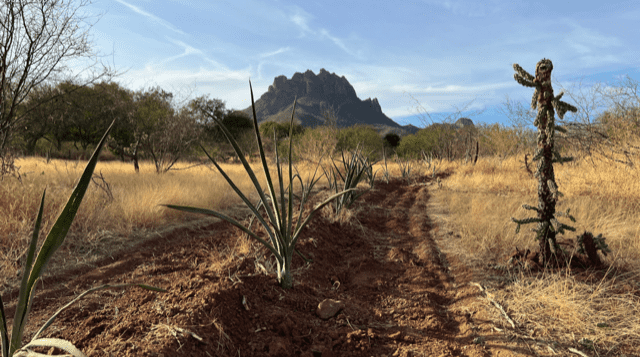
As they were discussing the Sonora project, Trapp says that “I turned to him and said don’t you want to make a local Guanajuato mezcal?” Maier got really excited and brought his partners in. Together they founded the Casa Agave company. That prompted the search for someone to realize the vision of a local mezcal. For Trapp that was the final piece of the puzzle, because now she had figured out how to utilize the piña from the agaves instead of leaving them to decompose, which would have released all of that captured carbon.
Agave history in Guanajuato was vital well into the 20th Century because of the pulque industry. The state’s mezcal history is lesser known but floats under it like the Titanic’s iceberg. Juan Gallardo Valdez has written an entire book on the topic called Historia del Mezcal Guanajuatense which examines the haciendas that produced mezcal and boomed in the area through the 19th Century.
Mexican authorities recognized this history by including portions of Guanajuato in the Mezcal Denominación in 2001. Notable brands like Jaral de Berrio and Marqués have exported to the U.S. while others have only distributed locally. These were all larger distillers based on the large land holdings of their haciendas. The dominant local tradition was very similar to tequila. It used above ground mamposteria ovens and shared the economy of scale structure that came with the haciendas. Local variations range from the use of Salmiana agaves (which crossed over from pulque production) to a wide variety of fermentation vessels, and even a tantalizing history of storing mezcal in barrels.
The **who** of Casa Agave’s mezcal may be a real tip off to where everything is headed because the distiller who will be making mezcal from the Casa Agave agaves is Germán González. He made his name with the tequila brands T1 and Tears of Llorona and hails from a four generation long tequila lineage with his father, Guillermo González Diaz Lombardo, being one of the most well known. Diaz Lombardo founded Chinaco Tequila in Tamaulipas making it one of the only prominent tequila brands from outside of Jalisco.
That openness to looking outside of the known is part of what is driving Germán González’s participation in Casa Agave. He has been in the tequila industry for quite some time and has personally witnessed all the issues there: Monoculture driven plagues, widespread pollution, and a general absence of interest in sustainability. He was looking to do something outside of tequila that would also be a model to the sector. While he’d entertained many other ideas, he says Casa Agave grabbed his attention because it’s a model of “sustainability, a new vision that we need. I hope that with the reforestation model, we can send a signal to tequila that it’s possible. It would be a win-win for all.”
He is also excited that this project doesn’t bind him to any rules or structures. The Casa Agave spirit is made outside of Mexico’s appellations and the regulations that come with them so it will be a destilado de agave. When I spoke with him he said he’d been researching rural distilleries in Tamaulipas and is open to inspirations from a variety of fronts. He says that “we’ll work with some techniques from Oaxaca, adding some ideas from Guanajuato, and my knowledge comes from Tequila, so we’ll make a meld of ideas and techniques to make something that I have always looked for in a mezcal or agave spirit.” He is also fascinated by the opportunity to “get the most refined flavors out of Salmiana. I love it because of all its herbal notes,” noting that it used to be part of the tequila DO but that its flavor has tragically been outside of tequila’s living memory.
González has already produced a test distillation from the Casa Agave Salmiana. They have anointed their brand “Atzin” which means “sacred water of life” in Nahuatl in reference to the local pyramid’s liquid observatory and the obvious link between alcohol and altered states. Casa Agave has ambitious plans to power the distillery with renewable energy and to release their first expression in 2024.
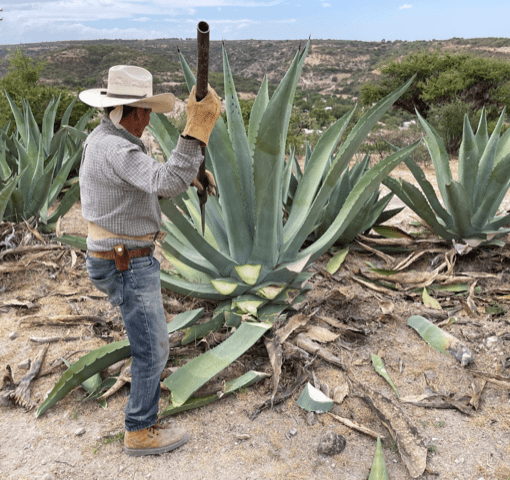

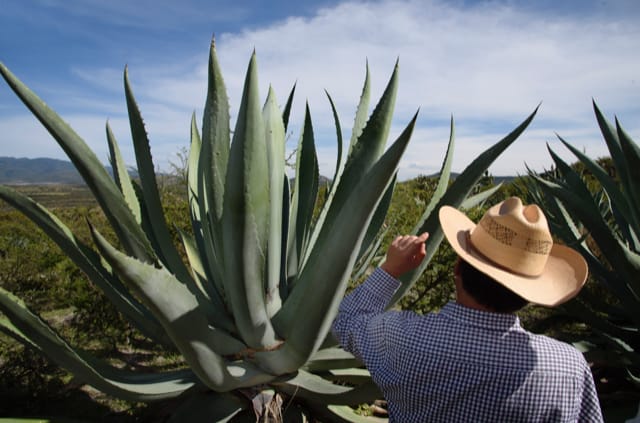
Atzin is being designed from the ground up as a carbon negative, zero waste product where the environmental impact becomes positive. Trapp is also working with scientists in order to develop a process to render the highly alkaline liquid waste, or viñaza, pH neutral.
The funny thing is that the mezcal is almost besides the point. Jose Flores notes that “mezcal is one of the worst uses of maguey, it’s very romantic, but not very productive,” because it only uses 2% of the agave’s biomass while the rest goes to waste. That’s a sobering perspective on the state of the agave spirits industry at large and punctuates Trapp’s entire philosophy: She wants to use 100% of the plant and saw the heart of the agave as the last challenge with mezcal production providing the solution.
Nothing in isolation
Everything in the Casa Agave business is designed to be picked up and used by anyone else in the industry. The Zamarripa shredder is ready to go for small farmers and ranchers. The Agavesse System is a model that can be readily adapted by anyone who knows about it. But the real potential is much larger. If the mezcal industry, especially the tequila industry just over the border in Jalisco, were to take up some of the initiatives demonstrated in Guanajuato, then the entire industry could become much more sustainable and give much more back to the communities that make it. And, it could reduce or eliminate its carbon footprint while also removing the massive waste that it leaves behind.
Video of Agavesse system
But the impact on the mezcal industry is tiny when compared with the global potential. The climate change creating the drought in Guanajuato isn’t unique to the area nor the US Southwest. Similar conditions and radical climatic changes are intensifying or appearing across the globe, especially in arid areas like South Africa and Australia.
It just so happens that all of these places are already producing agave spirits, partially because they’re trying to find crops that they can productively grow in the area and distillation seems to be an obvious answer. California recently recognized its own agave spirits category and is hosting a larger scale agricultural experiment with agaves to see if they can be farmed on marginal land. The affinity between Trapp’s project with what’s happening in California is obvious. This sort of project could assist arid zones with water conservation while maintaining local agricultural and ranching traditions.
Jose Flores looks at this like the engineer that he is. He thinks this is a “good opportunity to spread a benefit for humanity while obtaining some economic benefit and diversifying our income. And, yes, this truly is a very rewarding and interesting endeavor.” That analysis combines the importance of making this sort of project economically feasible and attractive to farmers and ranchers while providing solutions to the existential problems we’re facing.
Trapp’s larger vision is to bring optimism back into the challenge of climate change. “My thing is to give solutions to fight the hopelessness that exists. There are a lot of solutions coming and there are reasons to be hopeful. Creativity is infinite, you need good minds to put their minds to it.” She embodies that idea. When talking to her you can’t help but become more hopeful even after having consumed the latest pessimistic global temperature projections over breakfast.
That sort of fervor is shared by everyone involved in Casa Agave. Maier told me that he could easily start another mezcal, “I could make 50 more, but that’s not the point, we want to do more.” He went on to enthusiastically describe just how exciting it is to work with the entire team. “We need to do something different to take care of the earth. Everyone that is part of the team is getting excited because we could affect a lot of people around the world using agave as a regenerative system.”
Full disclosure: Mezcalistas co-founder Susan Coss worked on a paid writing project with Casa Agave this past summer.

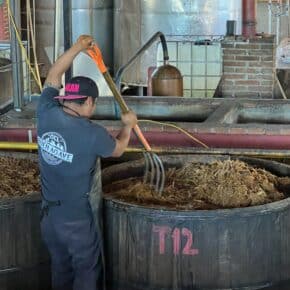
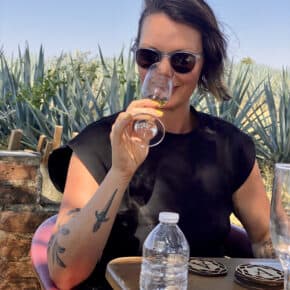
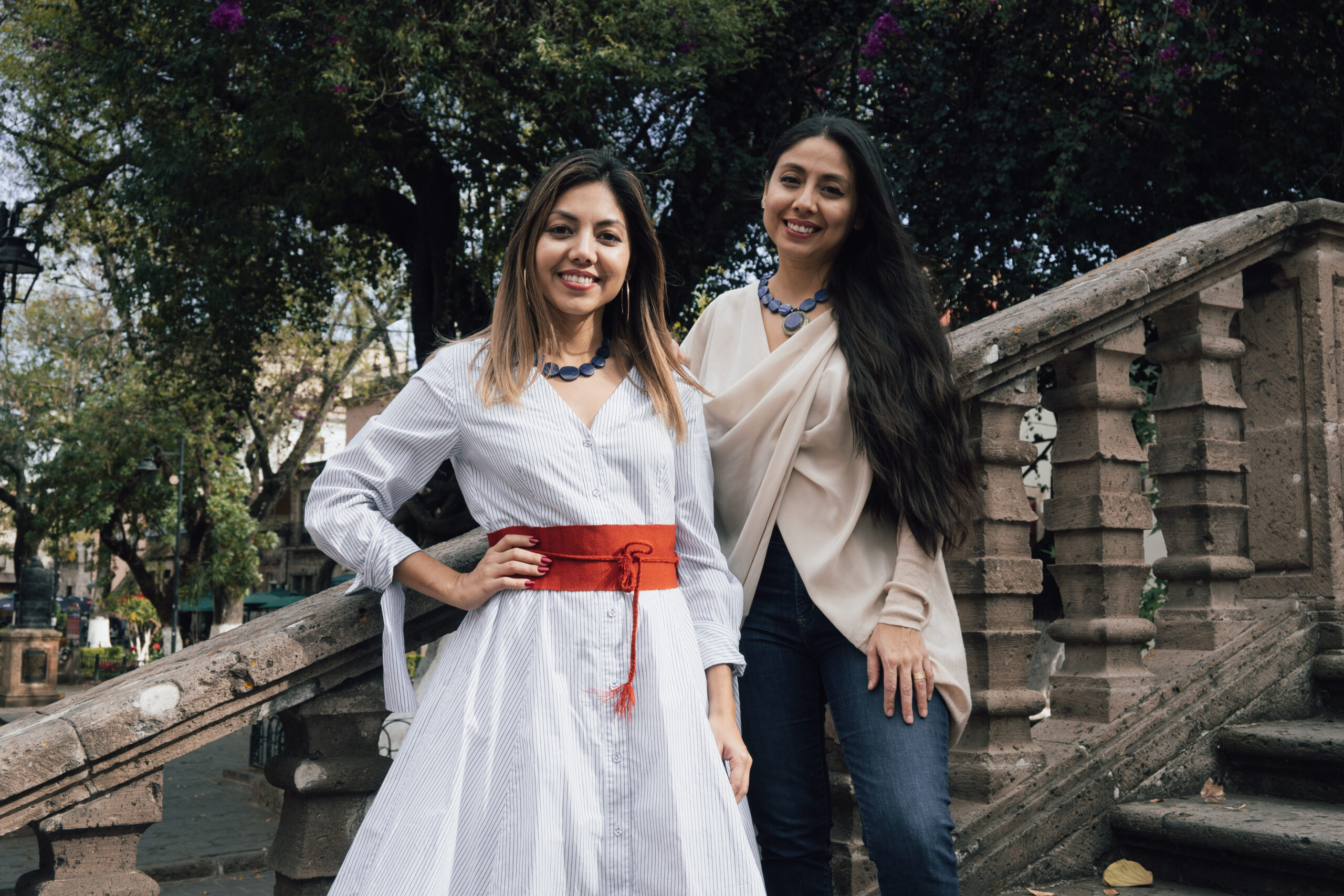









Muy bien condensado y transmitido mensaje. Creo que se deja implícito lo que en México hace falta en las comunidades rurales: el liderazgo y muchas veces el recurso para continuar y concluir. En lo personal he dedicado 40 años de mi vida profesional a la propagación de plantas in vitro y dentro de esto le entregamos a Tequila Sauza 27 millones de agaves de 2000 a 2019. Esto demuestra que es posible usar la tecnología con fines de reforestación intensa, como los que se proponen en Guanajuatom Brazil, Australia,… Estoy en contacto con muchos de ellos, ya retirado de mi empleo y ahora como emprendedor, para poder lanzar iniciativas en donde sabemos que es posible no solo multiplicar a gran escala, sino introducir variabilidad genética a través de la constante selección y mejoramiento.
En este retiro activo que inicié hace tres años, mi fin último es ayudar a las comunidades productoras de cacao, aprendiendo y enseñanado a crear y compartir valor. Parte del sueño es hacer chocolates (que ya se producen y venden). La parte más grande es integrar todos estos conceptos de agricultura regenerativa y bioeconomía circular para combatir la pobreza y contribuir a la protección del medio ambiente. En este contexto, este artículo es sumamente enriquecedor en ideas, aleccionador y altamente motivante, para seguir adelante. Gracias.